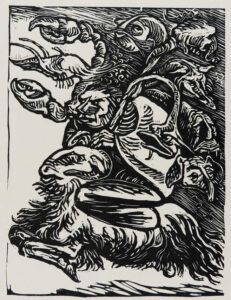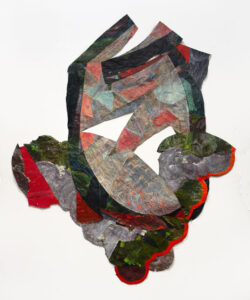
Bestiary: Animals as Symbols and Metaphors
Two- and three-dimensional representations of familiar animals, many of which are quite benign and intriguing.

Two- and three-dimensional representations of familiar animals, many of which are quite benign and intriguing.

This exhibition offers new ways of looking at three-dimensional objects. Whether forms that no longer serve their original intent, eye-catching works that avoid specific contexts, witty re-interpretations of objects, or illusionistic wonders, the artworks included in Ostensibly So reflect a fascination with and exploration of the methods and materials of artmaking as well as the concepts of form and function.

From the mid 1930s to mid 1950s, artist Mary Ellen Bute produced more than a dozen pioneering animations that sought to allow viewers to see sound.

This exhibition features new work by MFA students in the UNC Greensboro School of Art.

As humans, we are subject to the perception of others at any moment.

Lorraine O’Grady: Both/And, on loan from the Brooklyn Museum in New York, is the first comprehensive overview of the work of Lorraine O’Grady (born in Boston, 1934), one of the most significant figures in contemporary performance, conceptual, and feminist art.

In Angela Fraleigh’s dynamic paintings, female subjects culled from art history become active protagonists in newly imagined spaces.

Early in the twentieth century, during Japan’s rapid Westernization and industrialization, a desire to revive the great Japanese tradition of woodblock prints (known as ukiyo-e) in the context of Japan’s dynamic, modern life gave rise to an art movement known as shin hanga, or the “new print.” Beginning around 1915, a small group of artists mingled the old with the new, creating beautiful, enticing pictures that were reproduced as prints of almost unsurpassed quality.
Seven Masters: 20th-Century Japanese Woodblock Prints focuses on seven artists who played a significant role in the development of the shin hanga print, and whose works boldly exemplify this new movement: Hashiguchi Goyō, Kawase Hasui, Yamamura Kōka, Torii Kotondo, Itō Shinsui, Yamakawa Shūhō, and Natori Shunsen. The 75 woodblock prints are drawn from the superb collection at the Minneapolis Institute of Art and feature three themes: Kabuki actors, beautiful women, and landscapes. In addition to their enticing imagery, the materials used in creating the works captivate as well. Shin hanga prints were made using thick mulberry paper, rich mineral pigments, featured special elements like embossing and mica backgrounds, and emphasized the swirly movement of the rubbing tool, or baren. While 18th and 19th century ukiyo-e prints had been printed by the hundreds—even thousands for the most popular designs—shin hanga prints were produced in limited editions to guarantee exclusivity.
The Weatherspoon Art Museum owns a collection of over 400 Japanese woodblock prints, dating from the 18th-20th century. Due to their light sensitivity, prints from the Lenoir C. Wright Collection are only exhibited on an occasional basis, but many can be seen online through the museum’s collection page. In addition, fourteen prints that reflect themes found in Seven Masters: 20th-Century Japanese Woodblock Prints are featured HERE.
Click HERE to access the UNC Greensboro University Libraries Resource Guide for Seven Masters.
Seven Masters: 20th-Century Japanese Woodblock Prints was organized by the Minneapolis Institute of Art and is toured by International Arts & Artists, Washington, DC. Its presentation at the Weatherspoon Art Museum was facilitated by Elaine D. Gustafson, Curator of Collections.
RELATED PROGRAMS:
The Story behind the Beauty: Geisha, New Women, and Social Reformers • Wednesday, Sep 22 @ 4pm, virtual event
How Do I Look: Seeing with Expert Eyes • Friday, Oct 1 @ 4pm, virtual event
The Women of Shin Hanga, Lecture by Nozomi Naoi • Tuesday, Nov 16 @ 8pm, virtual event

The Weatherspoon is pleased to announce the 46th presentation of Art on Paper.

Born in Europe in the aftermath of World War I, Surrealism arrived in America shortly thereafter and was enthusiastically embraced by a broad segment of artists.

Eminent among a second generation of postwar American abstract artists, Helen Frankenthaler’s invention of the soak-stain technique expanded abstract painting possibilities while referencing figuration and landscape in unique ways.

This year’s exhibition will feature work by both our 2020 graduates and 2021 candidates.
HOURS:
Tue-Wed-Fri-Sat: 10am-5pm
Thu: 10am-8pm
Closed Sundays, Mondays + holidays
Weatherspoon Art Museum
UNC Greensboro
1005 Spring Garden Street
Greensboro, NC 27412
NOTE: The museum is temporarily closed May 26-August 13, 2024 for facility renovations.
Thank you for coming to this page to re-confirm your WAM e-news subscription.
Due to CAN-SPAM rules the only way to reinstate your subscription to WAM e-news is to re-enter your email in the form below.
After submitting you will receive a confirmation email. If you do not see the confirmation email check in your spam folder. You will have to confirm your subscription from that email in order to be added to our list.
If you still haven't received the confirmation email, please contact us at weatherspoon@uncg.edu.
Privacy Policy: UNC Greensboro will not share your personal information or email address with any other organization.
The CAN-SPAM Act is a law that sets the rules for commercial email, establishes requirements for commercial messages, gives recipients the right to have you stop emailing them, and spells out tough penalties for violations.